
Centre of Jaina Studies Newsletter: SOAS - University of London
The 14th World Sanskrit Conference was held on 1-5 September 2009 at Kyoto University, Kyoto, Japan. It was the third time the conference was held in Asia, after Varanasi 1981 and Bangalore 1997. Nearly five hundred Sanskrit scholars attended from all over the world. They discussed many topics, divided into fifteen sections and two special panels, and exchanged views even after sessions were closed. The scheduled events ran quite punctually in six rooms simultaneously and everything was well organized throughout the conference. The Jaina Studies Panel, Section 10, organised by Professor Nalini Balbir (University of Paris-III Sorbonne-Nouvelle), Dr Fumio Enomoto (Osaka University), Dr Peter Flügel (SOAS) and Dr Sin Fujinaga (Miyakonojō National College of Technology) held sessions on the second day of the five day conference, and eleven papers were read. In addition, three more papers concerning Jainism were read in other sections. Here I report briefly about these papers.
The first session of the Jaina Studies section, chaired by Peter Flügel (SOAS), comprised three papers. Bansidhar Bhatt (University of Münster) spoke on "Jainism and Śaivism: Interaction and Counteraction" about the relationship between Jainism and the Pāśupata school of Śaivism, using early Śaiva texts with reference to Alsdorf's work on the Kalpasūtra 1.36 and Colette Caillat's on Śaivasiddhānta. Next, Pochi Huang (National Chengchi University, Taipei) presented "What is the Fourfold Restraint that a Nigaṇṭha Bound? - Jainism and Buddhism in Interaction". His paper focused on the conceptual differences in some terms in the canonical texts of Jainism and Buddhism. The last paper of the session, presented by Yutaka Kawasaki (Osaka University) was "Mahāvīra's Body and the Buddha's Body: Some Remarks". It examined the physical characteristics of the "great beings" in both religions. He used the Śvetāmbara āgamic text Aupapātika as a source for this paper and compared the distinguishing marks of the bodies of the Jinas with the Buddha's 32 major marks (mahāpuruṣalakṣaṇa) and 80 minor marks (anuvyañjana), which are described in both Buddhist Pāli texts and Chinese translations. A detailed handout was circulated summarizing past research on the topic both in Jainism and Buddhism. His research method was sound and the topic will be developed further.
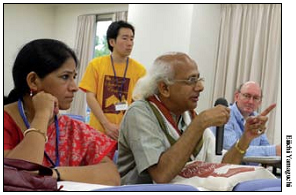
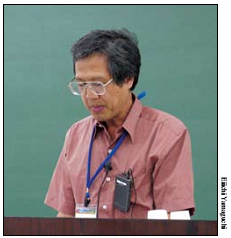
Pochi Huang (National Chengchi University, Taipei)
The second section was chaired by Fumio Enomoto (Osaka University). Ayako Yagi (Kyoto University) presented her "Reconsideration of 'Aṅgutta-Nikāya' II IV. 195", which was read at the same time as Robert Zydenbos's paper concerning Jainism in another section (see below), so I could not hear her paper. According to her abstract, this paper reconsiders the different emphasis that distinguishes Buddhism from Jainism in the Buddhist Pāli canon, Aṅgutta-Nikāya. The Aṅgutta-Nikāya and the Jaina canon have many words in common, as pointed out in an article by Richard Gombrich. Through examining Jaina canonical texts like the Uttarajjhāyā and Āyāraṅgasutta, Yagi concluded that the reason for the difference is that the Jainas focus on bodily activities and the Buddhists on mental activities. Kenji Watanabe (Taisho University, Tokyo) presented "Two Different Versions in the Extant Jaina Āgamas", the title slightly changed from the abstract. He discussed the Uttarajjhāyā, and the early Buddhist canon Dhammapada. With regard to the metaphor of water and the lotus leaf, he showed that the word brāhmaṇa is used not only for "Buddha" and "Arhat" in Buddhist Pāli sources, but also for "Mahāvīra", but only in early Jainism, as the form of māhaṇa in Ardha Māgadhī. Then he focused on two characteristic variants of reading in the Uttarajjhāyā, i.e. the locative plural endings -esu supported by many modern editions and the oblique plural endings -ehiṃ found in Cuṇṇi commentary traditions. Watanabe suggested that this difference is caused by the transposition from old Ardha Māgadhī, influenced by the Eastern dialect, to Pāli, as in Lüders's hypothesis. He speculated that the Cuṇṇi readings are older. MarieHélène Gorisse (University of Lille 3, France) spoke on "Prabhācandra's śabda-naya: Criticising the Grammarians from a Logical Point of View". She challenged philosophical approaches to the definition of śabda-naya, and discussed it in the context of Prabhācandra's encyclopedic work Prameyakamalamārtaṇḍa on Māṇikyanandī's Parikṣāmukhasūtra. From the grammarian's point of view, she described how Jaina logic gives the theory of meaning as a theory of knowledge and a theory of standpoints. She pursued her analysis from the point view of contemporary pluralism, namely the Erlangen School of Dialogical Logic.
The third session was chaired by Nalini Balbir (University of Paris-III Sorbonne-Nouvelle). Tomoyuki Uno (Chikushi Women's University, Fukuoka, Japan) began his talk "On Bhadrabāhu's Logic" by showing the difference in the syllogisms between Dignāga's Buddhist logic and Jinabhadra's Jaina logic. Then referring to reconstruction of a theory of knowledge from jñāna-theory to pramāṇa-theory in Jaina āgamas, he explained that Bhadrabāhu's early Jaina logic cannot be considered without connecting it to the āgama (jinavacana), which is absolutely correct for all Jaina followers. That is why, he concluded, that Badrabāhu's syllogism has a unique form and his logic can be called neither "inductive" nor "deductive". Robert Zydenbos's (University of Munich) paper "The Jaina Philosopher Bhāvasena and a Paradigm for the Science of Religion" treated a thirteenth century South Indian Digambara Jaina philosopher, Bhāvasena. Though his work comprised only ten titles, they summarized the Jaina attitude towards other schools of thought like Vedānta and Mīmāṃsā at the time. Furthermore, according to Zydenbos, Bhāvasena's discussion in works like Viśvatattvaprakāśa is more sophisticated than that of the famous Śvetāmbara writers Haribhadra and Hemacandra, and is valuable even for scholars of religion in general today.
The last Jaina Studies section was chaired by Tomoyuki Uno (Chikushi Women's University, Fukuoka, Japan). Eva De Clercq's (University of Würzburg) "The Bhaṭṭārakas of Fifteenth Century Gwalior" examined the bhaṭṭārakas, mentioned in the Apabhraṁśa poet Raidhū's compositions. He was a bhaṭṭāraka who worked in the Gwalior court and the Digambara Jaina community. A bhaṭṭāraka was a celibate layperson, but had a lineage like monks and served variously in a leading role within the Digambara Jaina communities. Examining Raidhū's works, she identified three lineages of bhaṭṭārakas in the fifteenth century in Gwalior and all the lineages belonging to the Māthura Gaccha. A member of the audience added further information on the historically significant Māthura Gaccha, which does not exist anymore in India today, although bhaṭṭārakas still exist in some areas. Nalini Balbir's (University of Paris-III Sorbonne-Nouvelle) paper on "Exegetical Strategies: The Example of Samayasundara's 'Kalpalatā'" focused on one of the commentaries of the Kalpasūtra, and discussed why sanskritisation and vernacularisation occurred in Jaina works. Samayasundara was a seventeenth century Śvetāmbara monk, belonging to the Kharatara Gaccha, who composed several works in Sanskrit, Prākrit and vernacular languages (Gujarati and Rajasthani). Balbir clarified the reason for the sanskritisation and the vernacularisation in the Kalpasūtra commentaries, which are often used for teaching inexperienced monks and lay people about Jainism during paryuṣaṇa, the rainy season retreat for monks. That is why commentaries used a vernacular language so that lay people could understand it more easily. The Kalpalatā was written from the standpoint of the Kharatara Gaccha, and is today used as a standard text to learn about Kalpasūtra in the Kharatara Gaccha, although the Tapā Gaccha has some different opinions, such as the transfer of the Mahāvīra's embryo, and uses Vinayavijayagaṇi's Subodhikā for this purpose. Peter Flügel (SOAS) spoke on "Concepts of Power in the Jaina Tradition", using the text Tiloyapaṇṇattī of Yativṛṣabha of ca. the fifth to seventh centuries. In Indian classical Jaina philosophy, "power" is considered in two different respects: the power of asceticism (tapas) to create ascetic power (ṛddhi or śakti), and political power (kṣatra). He argued that the canonical Jaina doctrine of karman can also be understood as a material theory of power. His analysis of the variety of powers (ṛddhi) mentioned in Tiloyapaṇṇattī shows that power is conceived as having the potential to affect not only one's personal karmic transformative body, but also other people and society, in a instrumental rather than merely miraculous fashion.
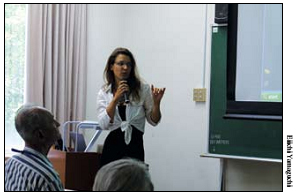
Hélène Gorisse (University of Lille 3, France)
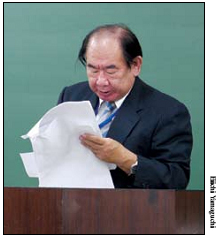
Kenji Watanabe (Taisho University, Tokyo)
In addition to the Jaina Studies section, three papers read in other sections focused on Jainism. Audrey Truschke's (Colombia University) "Akbar as Shah or Raja? Reimaginations of Encounters with the Mughal Court in Jaina Sanskrit Literature" was read in the Sanskrit and Regional Language and Literature section. She focused on some Jaina works in the late sixteenth through the early seventeenth centuries when Akbar and Jahangir reigned in the Mughal Empire. She addressed how Jaina works portray Mughal culture from a Sanskrit perspective. Using the prabandha texts of Śvetāmbara Jains in Gujarat, both in the Tapa Gaccha and the Kharatara Gaccha, she looked at "reimaginations" of the Mughals in three major areas: military conquest, court culture, and religious practices. This paper highlighted the usefulness of Jaina works in gathering information about the Muslim court and Brahmanical texts. In the Buddhist Studies section, Piotr Balcerowicz (University of Warsaw) read "Omniscience of the Jina and the Truth of Jainism". This paper discussed the theory of knowledge in Jainism compared to other philosophical schools such as Mīmāṃsā and Buddhist logicians. Kundakunda's Pravacanasāra showed the oldest argument for the justification of the truth of the Jina's teaching (jinavacana). In Samanthabhadra's Āptamīmāṃsā, the proof of the infallibility of the Jina's teaching (jinavacana) and the authority of the Jina (āptatva) is based of the five kinds of cognition in the Tattvārthādhigamasūtra which are arranged according to their purity and existed from the outset of Jainism. He concluded that omniscience in Jainism is realised by gradual development, but that the logical arguments presented by Jaina thinkers to defend the notion of omniscience are logically unsound. In "Jain Authorship in Tamil Literature: A Reassessment" Takanobu Takahashi (University of Tokyo) examined the authorship of socalled "Jaina works". Many important works in Tamil literature have been uncritically attributed to Jaina authors. This study scrutinised the evidence of Jaina authorship based on the content, and found evidence to the contrary. Even having little knowledge of Tamil language and literature, I understood the importance of this step to validate the evidence of authorship.
A note of thanks is due to Kyoto University, the host of the 14th World Sanskrit Conference, Kyoto 2009, for providing such an excellent forum in which to facilitate the exchange of knowledge shared in the Jaina Studies panel. The organizers of the Jaina Studies panel are also due appreciation for having ensured a productive and stimulating experience for all of the participants. We look forward to a continued exchange of ideas at the 15th World Sanskrit Conference to be held in Delhi in 2012.
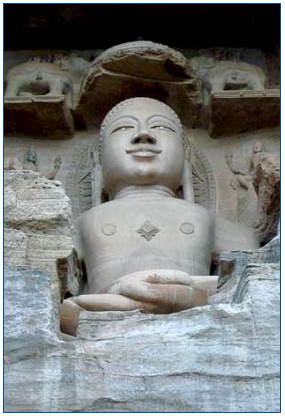
Digambara Jina in Gwalior, M.P. Photo: Peter Flügel
Eiichi Yamaguchi is a lecturer at the Department of General Arts, Ariake National College of Technology, Omuta, Fukuoka, Japan. His research focuses on Jaina philosophy as it pertains to religious practice in the Jaina community in Japan.
 Eiichi Yamaguchi
Eiichi Yamaguchi